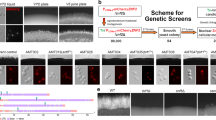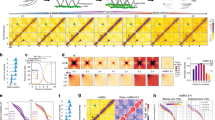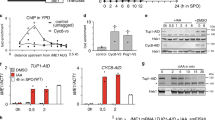Abstract
Sexual reproduction requires meiosis to produce haploid gametes, which in turn can fuse to regenerate a diploid organism. We have studied the transcriptional program that drives this developmental process in Schizosaccharomyces pombe using DNA microarrays. Here we show that hundreds of genes are regulated in successive waves of transcription that correlate with major biological events of meiosis and sporulation. Each wave is associated with specific promoter motifs. Clusters of neighboring genes (mostly close to telomeres) are co-expressed early in the process, which reflects a more global control of these genes. We find that two Atf-like transcription factors are essential for the expression of late genes and formation of spores, and identify dozens of potential Atf target genes. Comparison with the meiotic program of the distantly related Saccharomyces cerevisiae reveals an unexpectedly small shared meiotic transcriptome, suggesting that the transcriptional regulation of meiosis evolved independently in both species.
This is a preview of subscription content, access via your institution
Access options
Subscribe to this journal
Receive 12 print issues and online access
$209.00 per year
only $17.42 per issue
Buy this article
- Purchase on Springer Link
- Instant access to full article PDF
Prices may be subject to local taxes which are calculated during checkout




Similar content being viewed by others
References
Yamamoto, M., Imai, I. & Watanabe, Y. in The Molecular and Cellular Biology of the Yeast Saccharomyces: Life Cycle and Cell Biology (eds Pringle, J.R., Broach, J.R. & Jones, E.W.) 1035–1106 (Cold Spring Harbor Laboratory Press, Cold Spring Harbor, 1997).
Shalon, D., Smith, S.J. & Brown, P.O. A DNA microarray system for analyzing complex DNA samples using two-color fluorescent probe hybridization. Genome Res. 6, 639–645 (1996).
Wood, V. et al. The genome sequence of Schizosaccharomyces pombe. Nature 415, 871–880 (2002).
Iino, Y. & Yamamoto, M. Mutants of Schizosaccharomyces pombe which sporulate in the haploid state. Mol. Gen. Genet. 198, 416–421 (1985).
Nurse, P. Mutants of the fission yeast Schizosaccharomyces pombe which alter the shift between cell proliferation and sporulation. Mol. Gen. Genet. 198, 497 (1985).
Petersen, J., Weilguny, D., Egel, R. & Nielsen, O. Characterization of fus1 of Schizosaccharomyces pombe: a developmentally controlled function needed for conjugation. Mol. Cell. Biol. 15, 3697–3707 (1995).
Sugimoto, A., Iino, Y., Maeda, T., Watanabe, Y. & Yamamoto, M. Schizosaccharomyces pombe ste11+ encodes a transcription factor with an HMG motif that is a critical regulator of sexual development. Genes Dev. 5, 1990–1999 (1991).
Yamamoto, A. & Hiraoka, Y. How do meiotic chromosomes meet their homologous partners? Lessons from fission yeast. BioEssays 23, 526–533 (2001).
Davis, L. & Smith, G.R. Meiotic recombination and chromosome segregation in Schizosaccharomyces pombe. Proc. Natl Acad. Sci. USA 98, 8395–8402 (2001).
Lowndes, N.F., McInerny, C.J., Johnson, A.L., Fantes, P.A. & Johnston, L.H. Control of DNA synthesis genes in fission yeast by the cell-cycle gene cdc10+. Nature 355, 449–453 (1992).
Zhu, Y., Takeda, T., Nasmyth, K. & Jones, N. pct1+, which encodes a new DNA-binding partner of p85cdc10, is required for meiosis in the fission yeast Schizosaccharomyces pombe. Genes Dev. 8, 885–898 (1994).
Sugiyama, A., Tanaka, K., Okazaki, K., Nojima, H. & Okayama, H. A zinc finger protein controls the onset of premeiotic DNA synthesis of fission yeast in a Mei2-independent cascade. EMBO J. 13, 1881–1887 (1994).
Miyamoto, M., Tanaka, K. & Okayama, H. res2+, a new member of the cdc10+/SWI4 family, controls the 'start' of mitotic and meiotic cycles in fission yeast. EMBO J. 13, 1873–1880 (1994).
Ding, R. & Smith, G.R. Global control of meiotic recombination genes by Schizosaccharomyces pombe rec16 (rep1). Mol. Gen. Genet. 258, 663–670 (1998).
Asakawa, H., Kitamura, K. & Shimoda, C. A novel Cdc20-related WD-repeat protein, Fzr1, is required for spore formation in Schizosaccharomyces pombe. Mol. Genet. Genomics 265, 424–435 (2001).
Blanco, M.A., Pelloquin, L. & Moreno, S. Fission yeast mfr1 activates APC and coordinates meiotic nuclear division with sporulation. J. Cell Sci. 114, 2135–2143 (2001).
Cooper, K.F., Mallory, M.J., Egeland, D.B., Jarnik, M. & Strich, R. Ama1p is a meiosis-specific regulator of the anaphase promoting complex/cyclosome in yeast. Proc. Natl Acad. Sci. USA 97, 14548–14553 (2000).
Nakamura, T., Nakamura-Kubo, M., Hirata, A. & Shimoda, C. The Schizosaccharomyces pombe spo3+ gene is required for assembly of the forespore membrane and genetically interacts with psy1+-encoding syntaxin-like protein. Mol. Biol. Cell 12, 3955–3972 (2001).
Fares, H., Goetsch, L. & Pringle, J.R. Identification of a developmentally regulated septin and involvement of the septins in spore formation in Saccharomyces cerevisiae. J. Cell Biol. 132, 399–411 (1996).
Horie, S. et al. The Schizosaccharomyces pombe mei4+ gene encodes a meiosis-specific transcription factor containing a forkhead DNA-binding domain. Mol. Cell. Biol. 18, 2118–2129 (1998).
Abe, H. & Shimoda, C. Autoregulated expression of Schizosaccharomyces pombe meiosis-specific transcription factor Mei4 and a genome-wide search for its target genes. Genetics 154, 1497–1508 (2000).
Ohmiya, R., Kato, C., Yamada, H., Aiba, H. & Mizuno, T. Isolation of multicopy suppressors of the calcium sensitivity of a mutant lacking the bZIP transcription factor Atf1 in fission yeast. Mol. Gen. Genet. 261, 297–306 (1999).
Shiozaki, K. & Russell, P. Conjugation, meiosis, and the osmotic stress response are regulated by Spc1 kinase through Atf1 transcription factor in fission yeast. Genes Dev. 10, 2276–2288 (1996).
Nimmo, E.R., Cranston, G. & Allshire, R.C. Telomere-associated chromosome breakage in fission yeast results in variegated expression of adjacent genes. EMBO J. 13, 3801–3811 (1994).
Chu, S. et al. The transcriptional program of sporulation in budding yeast. Science 282, 699–705 (1998).
Primig, M. et al. The core meiotic transcriptome in budding yeasts. Nature Genet. 26, 415–423 (2000).
Moreno, S., Klar, A. & Nurse, P. Molecular genetic analysis of fission yeast Schizosaccharomyces pombe. Methods Enzymol. 194, 795–823 (1991).
Bähler, J. et al. Heterologous modules for efficient and versatile PCR-based gene targeting in Schizosaccharomyces pombe. Yeast 14, 943–951 (1998).
Eisen, M.B., Spellman, P.T., Brown, P.O. & Botstein, D. Cluster analysis and display of genome-wide expression patterns. Proc. Natl Acad. Sci. USA 95, 14863–14868 (1998).
Tusher, V.G., Tibshirani, R. & Chu, G. Significance analysis of microarrays applied to the ionizing radiation response. Proc. Natl Acad. Sci. USA 98, 5116–5121 (2001).
Acknowledgements
We thank D. Vetrie for help with microarray printing; H. Murakami for advice on pat1 experiments; H. Nojima for providing a meiotic cDNA library; C. Shimoda for strains, V. Wood for gene annotations and information on orphans and orthologs; members of our group for advice and discussions; and A. Bradley, J. Hayles, P. Nurse and M. Toone for comments on the manuscript. This research was funded by Cancer Research UK.
Author information
Authors and Affiliations
Corresponding author
Ethics declarations
Competing interests
The authors declare no competing financial interests.
Rights and permissions
About this article
Cite this article
Mata, J., Lyne, R., Burns, G. et al. The transcriptional program of meiosis and sporulation in fission yeast. Nat Genet 32, 143–147 (2002). https://doi.org/10.1038/ng951
Received:
Accepted:
Published:
Issue Date:
DOI: https://doi.org/10.1038/ng951
This article is cited by
-
An essential role for the Ino80 chromatin remodeling complex in regulation of gene expression during cellular quiescence
Chromosome Research (2023)
-
The inner nuclear membrane protein Lem2 coordinates RNA degradation at the nuclear periphery
Nature Structural & Molecular Biology (2022)
-
TOR targets an RNA processing network to regulate facultative heterochromatin, developmental gene expression and cell proliferation
Nature Cell Biology (2021)
-
Nutrient-sensitive heterochromatization by TOR
Nature Cell Biology (2021)
-
Expression of Mug14 is regulated by the transcription factor Rst2 through the cAMP-dependent protein kinase pathway in Schizosaccharomyces pombe
Current Genetics (2021)



